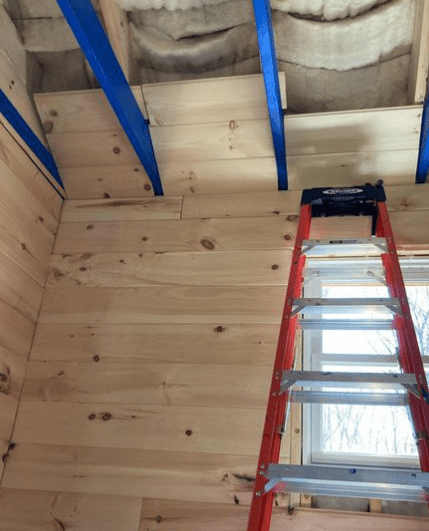I spent last weekend up at our camp installing tongue and groove pine paneling on the ceiling of our wee cabin. I finished one half of the ceiling (the majority of which went up last fall) and began to tackle the second half. It’s not as fun as it sounds. At the base of each section, I must negotiate trusses and so I’ve jury-rigged supports to provide a place to attach the paneling. After much trial and error on the first half, I stumbled into a process that worked. With that experience, and a process in place, the second half is going up much more smoothly.
At some point in the middle of working on the second half, in the midst of what I call my “crafter’s zen”, I thought: “I could write a manual on how to do this”.
I crack myself up.
It’s a Presbyterian thing. When experience and experimentation lead to effective process, we pull it all together into a tidy bundle and call it “Standing Rules” or “Committee on Ministry Manual”.
In Presbyterian polity it’s not just our collective experience that shapes governance. There’s a reason that the Book of Order is the second part of our Constitution. The first part is the Book of Confessions – a whirlwind tour of the church’s identity and theology throughout our history. In fact, if you read the small print in the Book of Order you’ll see references to the Confessions.
Sometimes things need to be tweaked (Exhibit A: Warped Boards[1]) but in general, following established process makes life a bit easier. When we adjust our processes to accommodate challenges, we need to do so with careful attention to the theology that undergirds all our governance. Remember, the policies in place are not just accumulated experience but also reflect our relationship with God and one another.
Over the next few months, you may hear a bit more about bylaws, manuals, etc. Some folks may see these as restrictions on what congregations can do, and other folks may find their heads nodding sleepily. I encourage you to try to see these efforts with new eyes and ears… these aren’t just a compilation of rules but reflect the story of how we as Presbyterians balance order and ardor to best accomplish the work we’ve been called to do as a community of faith!
(And, if you ever want to hear a sermon on the best practices for applying pine paneling in tight spots… give me a holler!)
Blessings –
Karen
[1] I initially meant this to refer to the tongue-and-groove pine boards that are sometimes not quite straight… but if your church has dysfunctional governing boards, this might also apply.

2 Comments
Making lessons and concepts relatable. You do this so well!!
Thanks!!